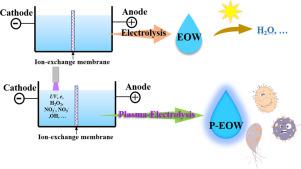Water Research ( IF 11.4 ) Pub Date : 2022-09-29 , DOI: 10.1016/j.watres.2022.119174 Jiao Lin 1 , Jishen Zhang 1 , Renwu Zhou 1 , Li Guo 1 , Dingxin Liu 1 , Mingzhe Rong 1 , Michael G Kong 2 , Kostya Ken Ostrikov 3

|
Pathogenic microorganisms pose a global threat to public health and environment. Common antibacterial chemicals produce toxic residues, inevitably harming the environment. Electrolyzed oxidizing water (EOW), a promising environment-friendly alternative disinfectant, still lacks effective production processes, sufficient bactericidal efficacy and stability, while the enabling physico-chemical mechanisms remain unclear. Here, we report, for the first time, an effective hybrid plasma electrochemical EOW production process and reveal the mechanisms by combining nonthermal plasmas and a two-chamber electrochemical cell separated by a cation exchange membrane (CEM) for decoupling the chemical reactions during the plasma treatment of water. Experimental results demonstrate that combined chlorine (chloramine) was the main chlorine product in the plasma-enhanced EOW (P-EOW) without a membrane, owing to the consumption of free chlorine (Cl2, HOCl, ClO−) by plasma-generated reactive nitrogen species. With a CEM in the plasma electrolysis system and through controlling the plasma discharge polarity, the production of free chlorine and other reactive species can be selectively controlled, with the highest concentration of free chlorine obtained in the negative plasma-enhanced EOW (NP-EOW). According to the transportation of cations by the CEM, the high concentrations of free chlorine may be attributed to the higher consuptions of H+ in cathode cell of negative plasma. The study of antibacterial ability of EOW produced under different conditions revealed that Staphylococcus aureus cells were best inactivated by the NP-EOW with CEM, which is mainly attributed to the higher concentration of free chlorine. This study demonstrates the feasibility of plasma-enhanced microbial electrolytic disinfection and offers new insights into the fundamental aspects of P-EOW chemistries for the future development of sustainable, efficient, and cost-effective multipurpose sustainable chemical technologies for water research and treatment.
中文翻译:

等离子增强微生物电解消毒:使用离子交换膜在等离子电解氧化水中解耦电化学和等离子化学
病原微生物对公共卫生和环境构成全球威胁。常见的抗菌化学品会产生有毒残留物,不可避免地危害环境。电解氧化水(EOW)是一种很有前途的环保替代消毒剂,但仍缺乏有效的生产工艺、足够的杀菌效力和稳定性,而其物理化学机制尚不清楚。在这里,我们首次报道了一种有效的混合等离子体电化学 EOW 生产工艺,并揭示了通过将非热等离子体和由阳离子交换膜 (CEM) 隔开的两室电化学电池相结合来解耦等离子体过程中的化学反应的机制水的处理。2 , HOCl, ClO - ) 由等离子体产生的活性氮物质。在等离子体电解系统中使用 CEM,通过控制等离子体放电极性,可以选择性地控制游离氯和其他活性物质的产生,在负等离子体增强 EOW (NP-EOW) 中获得最高浓度的游离氯. 根据 CEM 对阳离子的输送,游离氯的高浓度可能是由于负等离子体阴极电池中H +的消耗量较高。不同条件下产生的EOW的抗菌能力研究表明,金黄色葡萄球菌带有 CEM 的 NP-EOW 对细胞的灭活效果最好,这主要归因于较高浓度的游离氯。本研究证明了等离子体增强微生物电解消毒的可行性,并为未来开发用于水研究和处理的可持续、高效和具有成本效益的多用途可持续化学技术提供了对 P-EOW 化学基本方面的新见解。











































 京公网安备 11010802027423号
京公网安备 11010802027423号